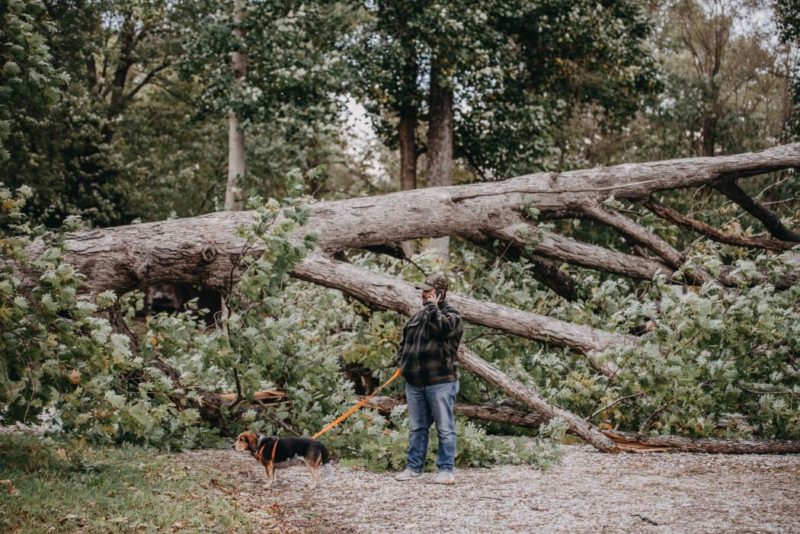Rain and wind in San Diego! It’s that time of the year when the residents of San Diego either get excited about finally getting a change in the weather or they find it distressing that their “perfect” sunny weather is getting disrupted. San Diego’s storm season typically occurs during the cooler months of December through March. While our storms are mild and cannot compare to the blizzards, tornadoes, hurricanes, and tumultuous lightning storms that take place throughout much of the country, our winter weather is still capable of causing its share of damage.
Unfortunately when the rain and winds push through San Diego, it is common to see trees topple on top of homes and other structures and our city roads. It doesn’t even take much for trees to start falling around our county. Depending on the tree and its circumstances, sometimes a slight gust will give it just the right push to expose its weakness. While some arborists disagree over whether some species are more prone to failure than others, the fact is that any tree has the potential to fall without any prior indication — even seemingly healthy trees.
The leading reason for tree failure lies in the combination of the tree’s weight and root structure. The denser the canopy of the tree and/or the larger and heavier the trunk, then the more weight the roots are required to support. The roots play a vital role in anchoring a tree, and when they are compromised by variables such as urban development, fungus, disease, and age, then a massive 70-ft tree per se will end up being more sensitive to the power of the wind.


WHAT TO DO IN A TREE FAILURE EMERGENCY?
If you are an unfortunate property owner with an unexpected fallen tree, the first step you should make is to ensure that everyone in the house or building is safe and take immediate medical action if any injuries were incurred. If the breakage poses any harm, such as broken glass or broken electrical wiring, then everyone should keep their distance or evacuate until the damage is inspected by trained professionals.
Once necessary medical attention is taken, then the next step is to either contact your insurance company or LC Tree Service to have a professional come assess the situation. We are available for emergency tree removals at all hours of the day or night. We even welcome you to contact other tree service companies, just to ensure that your property is taken care of as soon as possible and that you receive the best quote and service in such a dire situation.
CHOOSING AN EMERGENCY TREE SERVICE COMPANY
It is important to call a reputable company that has experience in emergency situations and in dealing with insurance companies. Hiring a licensed and insured tree company is a necessity, since emergency tree removals tend to be more hazardous than typical tree removals. Let’s face it — most tree projects don’t require safely cutting and discarding the trunk of a massive tree that has crashed through a roof and is currently hanging out in someone’s living room. Different protocols need to be undertaken, which experienced tree companies know and can execute as safely as possible.
In an emergency tree situation, never choose a tree service company that requires an upfront payment. These types of tree removals can be extremely difficult. And shamefully, it is not unheard of for a tree contractor to give up and walk away from a job. You shouldn’t be required to pay for the job until it is completed. That way you can trust that even when the job gets tough, your tree trimmers will press on and do what it takes to get the job done.
Emergency tree removals tend to be more expensive than other tree projects. This is due to multiple reasons. Emergencies require quick and immediate action, so scheduled jobs need to be moved around in order to accommodate a more pressing job. Occasionally, tree emergency calls come in the middle of the night, and depending the the urgency of the situation, we may come out to assess the scene immediately. Then if the removal needs prompt action, our removal crew will reassemble during the night hours, if necessary, to start the job. Otherwise, jobs that have high-alert status will be performed at the very start of the day. Another factor that leads to higher pricing involves the more hazardous nature of the project. The higher the risk, the higher the cost. Certain scenarios also require the use of heavy machinery, such as cranes, which adds the to the final quote of the job.
SHOULD YOU GO WITH THE LOWEST BID?
People tend to act quickly during emergency tree situations. Most tend to hire the first tree trimmer that they make contact with, while some gather multiple bids and go with the lowest bidder. However, the lowest bid may not necessarily be the best bid. It is helpful to do some background research on the tree company and ask questions. While it doesn’t pertain to all, some tree service companies are able to charge lower rates because of the lack of proper insurance and worker’s compensation. Others may the lack emergency tree experience, therefore resulting in an underbid. In this scenario, they may either raise the quote in the middle of the project or just take a loss on the job (hashtag learning lesson).
Instead, we encourage you to go with the company that you trust the most to perform the job properly and professionally — one that is licensed, insured, experienced, and recommended by others. Sometimes that may be the lowest bidder. But sometimes — hopefully not — it may be the highest. While our emergency tree removals are higher priced, LC Tree Service likes to stay on the competitive, yet reasonable, edge with our rates.
EMERGENCY TREE REMOVAL FROM THE ROOF OF A HOME IN SAN DIEGO
DEALING WITH YOUR INSURANCE COMPANY
Contacting your insurance company is one the first steps you should make. Most recommend that you contact them first, but in many of our emergency jobs, our customers chose to contact a tree company first. We would imagine that removing an unwelcome tree guest out of their home would be first on someone’s mind before the need for placing an insurance claim. Either way, whether you choose to call a tree service company first or your insurance company, it needs to be done immediately. It is important to know what your insurance will cover and what their policy is regarding vendor payments. You will need to know whether your insurance covers both the removal of the tree from structures and the ground or if it only covers removal from structures. Then depending on your policy, payment will either be handled 1)directly from the consumer to vendor, 2)from the insurance company to consumer to vendor, or 3)directly to the vendor from the insurance company.
WHAT IF A TREE FALLS ON YOUR NEIGHBOR’S PROPERTY?
If your tree falls on your neighbor’s property, or vice-versa — your neighbor’s tree falls on your property, the same steps should be taken. Both parties’ insurance companies need to be contacted and a tree service company needs to be contacted either by you or your neighbor. Each homeowner’s insurance will cover the damage caused to their client’s property. Then the neighbor’s insurance company (if your tree fell on their property) will later file a subrogation claim with your insurance company to recoup the cost caused by your tree failure.
HELPING TO PREVENT TREE FAILURE
It is important to keep your tree trimmed on a regular basis (every 1-2 years contingent on the species). Unmaintained trees with a dense canopy have more surface area for wind push. However, certain species, like the Ficus benjamina, usually possess dense canopies — but by nature, they also grow some of the sturdiest roots in San Diego. Therefore in most cases, you would be okay having a dense ficus in your backyard, as long as it has sufficient growing room for its roots. Other trees, like the eucaplytus, should be monitored regularly when they’re at a mature height and kept well-trimmed, as their roots are more shallow than other species.
If you have a large leaning tree, especially one that is situated on a slope, it is more important to monitor it and maintain a light canopy. Having a leaning trunk with a heavy top only imposes more stress on the roots to keep it upright. Some leaning trees fare just fine, however others with a weaker root system eventually fall under the pressure. So if you have a tree that is leaning towards your home or building, or your neighbor’s property, then to stay on the safe side, it would even be wise to have it removed.
While it is easy to monitor how top-heavy a tree is, analyzing the roots is a bit trickier. Thankfully, there are signs that you can look out for.
- If mushrooms are visible at the base of the trunk or anywhere underneath the tree’s canopy, then this is a sign that fungal growth is rotting away the tree’s roots.
- If your tree is diseased or old and nearing the end of its life cycle, then the entire framework is weakening, including its root system.
- Make sure that your large mature tree has plenty of room for root growth. If it is close to any development (i.e. roads, homes, buildings, pavement) then chances are that its anchoring system is compromised, therefore increasing its chances of failure.


